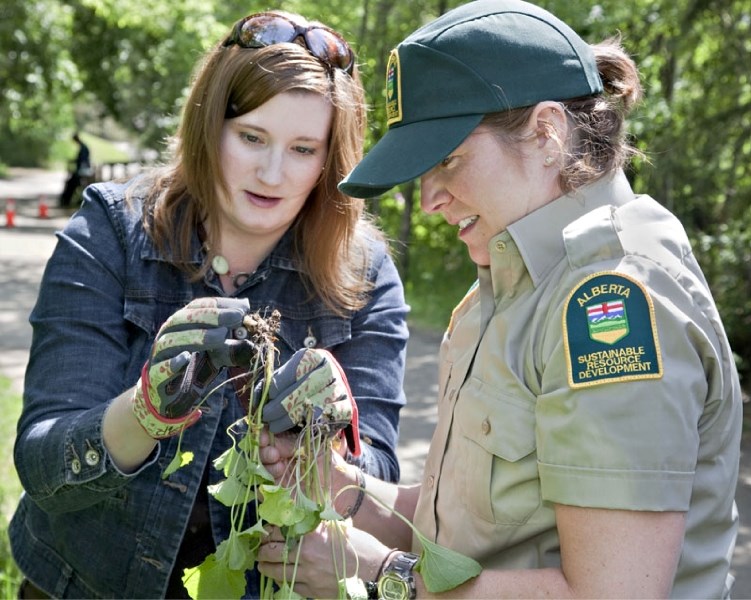Kevin Veenstra didn't have any trouble finding alien invaders last weekend. The St. Albert arborist was one of a handful of volunteers that scoured Edmonton's Mill Creek Ravine last Saturday in search of garlic mustard.
The sizeable patch, as large as one city block, is one of the few known places where this invasive plant has touched down in Alberta — one of the others is St. Albert. The plants formed a vast, thick carpet, Veenstra says and he barely put a dent in it despite pulling five bags worth. "They needed 200 volunteers, not 20."
Alberta Sustainable Resource Development Minister Mel Knight visited Edmonton's garlic mustard patch Monday to call on residents to stop the spread of invasive species.
Many summertime activities such as fishing, boating and gardening can spread damaging plants and animals, notes Trisha Anderson, spokesperson for Alberta Sustainable Resource Development. Her department is promoting simple steps people can take to keep these threats contained.
Alien watch
Biologists generally define invasive species as plants and animals that spread uncontrollably when introduced to an area in which they do not normally live, often to the detriment of native species.
Garlic mustard has dark green, scalloped leaves, small white flowers and a distinct garlic odour when crushed.
Garlic mustard is a problem because it spreads quickly, Veenstra says, and can take over a forest floor. Once it does, it changes the soil chemistry to kill other plants, including trees.
First spotted in St. Albert last year, the city used chemical sprays to eliminate most of it. "We pulled everything we could find about a month ago," Veenstra says, and they'll have to keep pulling for about six years before they're sure the plants are gone. "Thankfully, we haven't seen it anywhere else."
St. Albert is dealing with several invasive plants at the moment, Veenstra says, including purple loosestrife (tall and covered with purple flowers), scentless chamomile (yellow disk surrounded by many white petals) and Himalayan balsam (pink, looks like a British police helmet). It also has its eye out for orange hawkweed, which has been spotted in central Alberta.
Orange hawkweed has invaded rangeland and pastureland in Parkland County and might already be in Sturgeon County, says Maureen Vadnais, the Alberta Agriculture specialist known to some as the Weed Witch. "It's got an orange dandelion-like [petals] that are notched at the tip," she says, hairy stems and milky sap. These unpalatable plants can cover even well established grasslands with a dense mat of their progeny, robbing cows of their lunch.
Stopping the spread
The solution for most of these plants is pretty simple, Veenstra says — pull, pull, pull. Chemicals are often too dangerous or expensive to use, especially around water and most of the plants can be yanked by hand.
The flowering rush is an exception, he notes. Known for its bulrush-like leaves and clusters of pink flowers, there are about 200 of them in the Sturgeon River valley in St. Albert, and they can't be pulled — that would shred their roots, releasing scores of new potential plants into the water. "All we can do is crop it down."
Slowing the spread of invasive species is a matter of caution and sanitation, say Veenstra and Vaudnais. Never trade plants with a neighbour unless you know what you're getting and always clean your shoes, boats and fishing tackle before leaving a location.
People who suspect they have an invasive plant in their yard should call public works or Alberta Agriculture for advice. Visit invasiveplants.ab.ca for more on how to spot these plants.




